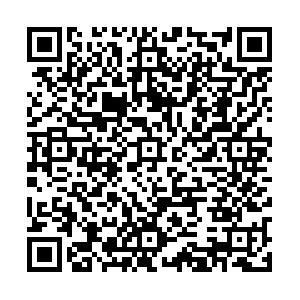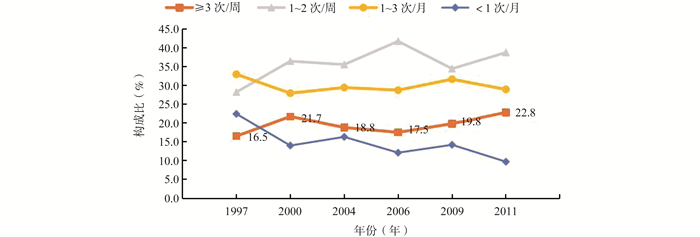Study on the relationship between sugar-sweetened beverage intake and central obesity in children and adolescents aged 7-17 years from 1997 to 2011 in China
-
摘要:
目的 探讨含糖饮料摄入与儿童青少年中心性肥胖的关系。 方法 利用“中国健康与营养调查”项目公开数据库中1997—2011年的横断面调查数据,分析中国7~17岁儿童青少年含糖饮料摄入与中心性肥胖的关系。根据腰围划分为正常组和中心性肥胖前期/中心性肥胖组,采用χ2检验比较不同组间差异,采用多因素Logistic回归分析模型分析含糖饮料对儿童青少年中心性肥胖的影响。 结果 1 916名7~17岁儿童青少年中,含糖饮料摄入频率≥3次/周、1~2次/周、1~3次/月和<1次/月分别为389人(20.3%)、712人(37.2%)、563人(29.4%)和252人(13.2%)。共计731例(38.2%)发生中心性肥胖前期/中心性肥胖,调整相关混杂因素后,与摄入含糖饮料<1次/月组相比,≥3次/周组增加68.0%的肥胖风险(95% CI:1.194~2.346,P=0.003);年龄、性别对含糖饮料摄入频率和中心性肥胖的关系无统计学影响。 结论 含糖饮料摄入频率增高会增加儿童青少年中心性肥胖发生风险。 Abstract:Objective To investgate the relationship between sugar-sweetened beverage intake and central obesity among children and adolescents. Methods We used the cross-sectional survey data from 1997 to 2011 in the open database of the "China Health and Nutrition Survey" project, and this study analyzed the relationship between sugar-sweetened beverage intake and central obesity among Chinese children aged 7-17 years. All participants were divided into normal group and pre-central obesity group/central obesity group by the waist circumference. We used the Chi-square test to compare the differences between different groups, and multivariate Logistic liner regression analysis model was used to analyze the influence of sugary drinks on central obesity in children and adolescents. Results Among 1 916 children aged 7 to 17 years, 389 (20.3%) had more than or equal to 3 times of intake of sugar-sweetened beverages per week, 712 (37.2%) had 1-2 times per week, 563 (29.4%) had 1-3 times per month and 252 (13.2%) had less than once a month group. A total of 731 cases (38.2%) developed pre-central obesity/central obesity. After adjusting for related confounding factors, compared with the group who consumes sugary drinks less than once a month group, the group had more than or equal to 3 times a week increased the risk of obesity by 68.0% (95% CI: 1.194-2.364, P=0.003). Besides, age and gender had no significant effect on the relationship between the frequency of sugar-sweetened beverage intake and central obesity. Conclusion Higher frequency of sugar-beverage intake can increase the risk of central obesity in children and adolescents. -
Key words:
- Children /
- Adolescents /
- Sugary drinks /
- Pre-central obesity /
- Central obesity
-
图 2 1997—2011年中国7~17岁儿童青少年年龄、性别分层后含糖饮料摄入频率与中心性肥胖的多因素分析a
注:a调整了年龄、性别、城乡、家庭人均年收入、总能量摄入和睡眠充足情况。
Figure 2. Multivariate analysis of the correlation between intake frequency of sugar-sweetened beverages and obesity stratified by age and gender in children and adolescents aged 7-17 years from 1997-2011 in China a
表 1 变量赋值
Table 1. Variable assignment
编码 变量 赋值 备注 Y 中心性肥胖 正常=1,中心性肥胖前期/中心性肥胖组=2 因变量 X1 含糖饮料摄入频率 <1次/月=1,1~3次/月=2,1~2次/周=3;≥3次/周=4 自变量 X2 年龄(岁) 7~<12=1,12~17=2 协变量 X3 性别 男=1,女=2 协变量 X4 城乡 农村=1,城市=2 协变量 X5 家庭人均年收入 低=1,中=2,高=3 协变量 X6 总能量摄入(%) <60=1,60~ < 80=2,80~ < 100=3;≥100=4 协变量 X7 睡眠充足情况 否=1,是=2 协变量 表 2 1997—2011年中国7~17岁儿童青少年基本特征[n(%)]
Table 2. Basic characteristics of children aged 7-17 years from 1997-2011 in China [n(%)]
特征 合计(N=1 916) 正常组(n=1 185) 中心性肥胖(n=731)a χ2值 P值 年龄(岁) 18.512 <0.001 7~<12 532(27.8) 370(31.2) 162(22.2) 12~17 1 384(72.2) 815(68.8) 569(77.8) 性别 1.349 0.245 男 982(51.3) 595(50.2) 387(52.9) 女 934(48.7) 590(49.8) 344(47.1) 城乡 20.154 <0.001 农村 1 279(66.7) 836(70.5) 443(60.7) 城市 637(33.3) 349(28.5) 288(39.3) 家庭人均年收入 9.663 0.008 低 1 213(63.8) 780(66.3) 433(59.6) 中 539(28.3) 315(26.8) 224(30.9) 高 150(7.9) 81(6.9) 69(9.5) 总能量摄入(%) 26.597 <0.001 <60 1 002(52.5) 670(56.7) 332(45.4) 60~<80 516(27.0) 304(25.7) 212(29.2) 80~<100 246(12.9) 133(11.3) 113(15.5) ≥100 146(7.6) 74(6.3) 72(9.9) 睡眠充足情况 1.790 0.181 否 1 493(77.9) 936(79.3) 557(76.7) 是 413(22.1) 244(20.7) 169(23.3) 含糖饮料摄入情况 是否摄入 16.938 0.001 否 252(13.2) 171(14.4) 81(11.1) 是 1 664(86.8) 1 014(85.6) 650(88.9) 摄入频率 <1次/月 252(13.2) 171(14.9) 81(11.0) 1~3次/月 563(29.3) 362(30.5) 201(27.5) 1~2次/周 712(37.2) 444(37.5) 268(36.7) ≥3次/周 389(20.3) 208(17.6) 181(24.8) 注:a包含中心性肥胖前期及中心性肥胖。 表 3 1997—2011年中国含糖饮料摄入与7~17岁儿童青少年中心性肥胖的多因素Logistic线性回归分析模型分析
Table 3. Logistic liner regression analysis of sugary beverage intake and obesity in children and adolescents aged 7-17 years from 1997-2011 in China
含糖饮料摄入 模型1a 模型2b 模型3c OR(95% CI)值 P值 OR(95% CI)值 P值 OR(95% CI)值 P值 <1次/月 1.000 1.000 1.000 1~3次/月 1.172(0.855~1.607) 0.324 1.182(0.859~1.625) 0.304 1.158(0.837~1.601) 0.375 1~2次/周 1.274(0.940~1.728) 0.119 1.263(0.929~1.718) 0.137 1.233(0.901~1.688) 0.190 ≥3次/周 1.837(1.319~2.558) < 0.001 1.761(1.260~2.462) 0.001 1.680(1.194~2.364) 0.003 Wald值 14.420 11.699 9.561 P值 < 0.001 0.001 0.002 注:a模型1未调整;b模型2调整了年龄、性别及城乡;c模型3在模型2的基础上调整家庭人均年收入、总能量摄入和睡眠充足情况。 表 4 1997—2011年中国7~17岁儿童青少年含糖饮料摄入与肥胖的敏感性分析
Table 4. Sensitivity analysis of sugar-sweetened beverage intake and obesity in children and adolescents aged 7-17 years from 1997-2011 in China
含糖饮料摄入 模型1a 模型2b OR(95% CI)值 P值 OR(95% CI)值 P值 <1次/月 1.000 1.000 1~3次/月 1.215(0.876~1.686) 0.243 1.200(0.712~2.021) 0.494 1~2次/周 1.316(0.958~1.808) 0.090 1.166(0.706~1.927) 0.548 ≥3次/周 1.832(1.296~2.590) < 0.001 1.829(1.068~3.132) 0.028 注:a调整了年龄、性别、城乡、家庭人均年收入、总能量摄入、睡眠充足情况及招募年份;b调整了年龄、性别、城乡、家庭人均年收入、总能量摄入、睡眠充足情况及经常参加体育活动情况。 -
[1] Güngör NK. Overweight and obesity in children and adolescents[J]. J Clin Res Pediatr Endocrinol, 2014, 6(3): 129-143. DOI: 10.4274/jcrpe.1471. [2] Xi B, Zong XN, Kelishadi R, et al. International waist circumference percentile cutoffs for central obesity in children and adolescents aged 6 to 18 years[J]. J Clin Endocrinol Metab, 2020, 105(4): e1569-e1583. DOI: 10.1210/clinem/dgz195. [3] Lobstein T, Baur L, Uauy R, et al. Obesity in children and young people: a crisis in public health[J]. Obes Rev, 2004, 5(Suppl 1): 4-104. DOI: 10.1111/j.1467-789x.2004.00133.x. [4] Pereira MA. Sugar-sweetened and artificially-sweetened beverages in relation to obesity risk[J]. Adv Nutr, 2014, 5(6): 797-808. DOI: 10.3945/an.114.007062. [5] Ayer J, Charakida M, Deanfield JE, et al. Lifetime risk: childhood obesity and cardiovascular risk[J]. Eur Heart J, 2015, 36(22): 1371-1376. DOI: 10.1093/eurheartj/ehv089. [6] Ludwig DS, Peterson KE, Gortmaker SL. Relation between consumption of sugar-sweetened drinks and childhood obesity: a prospective, observational analysis[J]. Lancet, 2001, 357(9255): 505-508. DOI: 10.1016/s0140-6736(00)04041-1. [7] Katzmarzyk PT, Broyles ST, Champagne CM, et al. Relationship between soft drink consumption and obesity in 9-11 years old children in a multi-national study[J]. Nutrients, 2016, 8(12): E770. DOI: 10.3390/nu8120770. [8] Bes-Rastrollo M, Sayon-Orea C, Ruiz-Canela M, et al. Impact of sugars and sugar taxation on body weight control: a comprehensive literature review[J]. Obesity (Silver Spring), 2016, 24(7): 1410-1426. DOI: 10.1002/oby.21535. [9] Keller A, Bucher Della Torre S. Sugar-sweetened beverages and obesity among children and adolescents: a review of systematic literature reviews[J]. Child Obes, 2015, 11(4): 338-346. DOI: 10.1089/chi.2014.0117. [10] Collison KS, Zaidi MZ, Subhani SN, et al. Sugar-sweetened carbonated beverage consumption correlates with BMI, waist circumference, and poor dietary choices in school children[J]. BMC Public Health, 2010, 10: 234. DOI: 10.1186/1471-2458-10-234. [11] Vinciguerra F, Tumminia A, Roppolo F, et al. Impact of unhealthy childhood and unfavorable parents' characteristics on adiposity in schoolchildren[J]. Diabetes Metab Res Rev, 2019, 35(8): e3199. DOI: 10.1002/dmrr.3199. [12] Hasnain SR, Singer MR, Bradlee ML, et al. Beverage intake in early childhood and change in body fat from preschool to adolescence[J]. Child Obes, 2014, 10(1): 42-49. DOI: 10.1089/chi.2013.0004. [13] Zhang B, Zhai FY, Du SF, et al. The China Health and Nutrition Survey, 1989-2011[J]. Obes Rev, 2014, 15 Suppl 1(1): 2-7. DOI: 10.1111/obr.12119. [14] 中国疾病预防控制中心营养与食品安全所, 湖北省疾病预防控制中心, 首都儿科研究所, 等. 人群健康监测人体测量方法[S]. 北京: 中华人民共和国卫生部, 2013.National institute for Nutrition and Health Chinese Center for Disease Control and Prevention, Hubei Provincial Center for Disease Control and prevention, Capital Institute of Pediatrics, et al. Anthropometric measurements method in health surveillance[S]. Beijing: Ministry of Health of the People's Republic of China, 2013. [15] 马冠生, 季成叶, 马军, 等. 中国7~18岁学龄儿童青少年腰围界值点研究[J]. 中华流行病学杂志, 2010, 31(6): 609-615. DOI: 10.3760/cma.j.issn.0254-6450.2010.06.003.Ma GS, Ji CY, Ma J, et al. Waist circumference reference values for screening cardiovascular risk factors in Chinese children and adolescents aged 7-18 years[J]. Chin J Epidemiol, 2010, 31(6): 609-615. DOI: 10.3760/cma.j.issn.0254-6450.2010.06.003. [16] Ardeshirlarijani E, Jalilpiran Y, Daneshzad E, et al. Association between sugar-sweetened beverages and waist circumference in adult populations: a meta-analysis of prospective cohort studies[J]. Clin Nutr ESPEN, 2021, 41: 118-125. DOI: 10.1016/j.clnesp.2020.10.014. [17] 中国营养学会. 中国居民膳食营养素参考摄入量[J]. 营养学报, 2001, 23(3): 193-196. DOI: 10.3321/j.issn:0512-7955.2001.03.001.Chinese Society for Nutrition. Chinese dietary reference intakes, DRIs[J]. Acta Nutr Sin, 2001, 23(3): 193-196. DOI: 10.3321/j.issn:0512-7955.2001.03.001. [18] Qi Q, Chu AY, Kang JH, et al. Sugar-sweetened beverages and genetic risk of obesity[J]. N Engl J Med, 2012, 367(15): 1387-1396. DOI: 10.1056/nejmoa1203039. [19] 国务院新闻办公室. 中国居民营养与慢性病状况报告(2020年)[EB/OL]. (2020-12-23)[2021-03-04]. http://www.scio.gov.cn/xwfbh/xwbfbh/wqfbh/42311/44583/index.htm#2, 2020-12-23.The Information Office of the State Council. Report on Chinese Residents' Chronic Diseases and Nutrition 2020[EB/OL]. (2020-12-23)[2021-03-04]. http://www.scio.gov.cn/xwfbh/xwbfbh/wqfbh/42311/44583/index.htm#2, 2020-12-23. [20] 白英龙, 许志勇, 牛欣, 等. 沈阳市初中生超重肥胖和含糖饮料摄入关联性分析[J]. 中国学校卫生, 2020, 41(1): 113-116. DOI: 10.16835/j.cnki.1000-9817.2020.01.030.Bai YL, Xu ZY, Niu X, et al. Correlation analysis between overweight and obesity and intake of sugary drinks among junior high school students in Shenyang[J]. Chin J Sch Heal, 2020, 41(1): 113-116. DOI: 10.16835/j.cnki.1000-9817.2020.01.030. [21] Wolfram G, Bechthold A, Boeing H, et al. Evidence-based guideline of the German Nutrition Society: fat intake and prevention of selected nutrition-related diseases[J]. Ann Nutr Metab, 2015, 67(3): 141-204. DOI:141. 10.1159/000437243. [22] Segovia J, Orellana M, Sarmiento JP, et al. The effects of taxing sugar-sweetened beverages in Ecuador: an analysis across different income and consumption groups[J]. PLoS One, 2020, 15(10): e0240546. DOI: 10.1371/journal.pone.0240546. [23] 张琴, 朱琰泓, 彭谦, 等. 周行为记录在小学生含糖饮料知信行综合干预应用中的效果评价[J]. 中国健康教育, 2021, 37(1): 63-66. DOI: 10.16168/j.cnki.issn.1002-9982.2021.01.013.Zhang Q, Zhu YH, Peng Q, et al. Effect of the application of weekly behavior records in comprehensive intervention on KAP of sugary beverages among pupils[J]. Chin J Heal Educ, 2021, 37(1): 63-66. DOI: 10.16168/j.cnki.issn.1002-9982.2021.01.013. [24] Lim S, Zoellner JM, Lee JM, et al. Obesity and sugar-sweetened beverages in African-American preschool children: a longitudinal study[J]. Obesity (Silver Spring), 2009, 17(6): 1262-1268. DOI: 10.1038/oby.2008.656. [25] de Ruyter JC, Olthof MR, Seidell JC, et al. A trial of sugar-free or sugar-sweetened beverages and body weight in children[J]. N Engl J Med, 2012, 367(15): 1397-1406. DOI: 10.1056/nejmoa1203034. [26] 张姝. 沈阳市某区初中生含糖饮料摄入情况与超重肥胖的相关性研究[D]. 大连: 大连医科大学, 2019.Zhang S. Study on the relationship between the intake of sugar-sweetened beverages and the overweight and obesity among junior high school students in A district of Shenyang[D]. Dalian: Dalian Medical University, 2019. [27] Malik VS, Schulze MB, Hu FB. Intake of sugar-sweetened beverages and weight gain: a systematic review[J]. Am J Clin Nutr, 2006, 84(2): 274-288. DOI: 10.1093/ajcn/84.1.274. [28] Nissinen K, Mikkilä V, Männistö S, et al. Sweets and sugar-sweetened soft drink intake in childhood in relation to adult BMI and overweight. The Cardiovascular Risk in Young Finns Study[J]. Public Health Nutr, 2009, 12(11): 2018-2026. DOI: 10.1017/s1368980009005849. [29] 穆亚平, 赵方, 马洪刚, 等. 儿童及青少年肥胖症糖脂代谢异常早期诊断和干预的研究[J]. 中国实用儿科杂志, 2011, 26(8): 587-591. https://www.cnki.com.cn/Article/CJFDTOTAL-ZSEK201108011.htmMu YP, Zhao F, Ma HG, et al. Research into abnormal glucose and lipid metabolism in early diagnosis and intervention in obese children and adolescents[J]. Chin J Pract Pediatr, 2011, 26(8): 587-591. https://www.cnki.com.cn/Article/CJFDTOTAL-ZSEK201108011.htm [30] Xia JY, Lloyd-Jones DM, Khan SS. Association of body mass index with mortality in cardiovascular disease: New insights into the obesity paradox from multiple perspectives[J]. Trends Cardiovasc Med, 2019, 29(4): 220-225. DOI: 10.1016/j.tcm.2018.08.006. [31] Lopez NV, Ayala GX, Corder K, et al. Parent support and parent-mediated behaviors are associated with children's sugary beverage consumption[J]. J Acad Nutr Diet, 2012, 112(4): 541-547. DOI: 10.1016/j.jand.2011.11.013. [32] Moreno MA, Furtner F, Rivara FP. Advice for patients. Sugary drinks and childhood obesity[J]. Arch Pediatr Adolesc Med, 2009, 163(4): 400. DOI: 10.1001/archpediatrics.2009.16. [33] Dehghan M, Akhtar-Danesh N, Merchant AT. Childhood obesity, prevalence and prevention[J]. Nutr J, 2005, 4: 24. DOI: 10.1186/1475-2891-4-24. -





 下载:
下载:


